The lovely soft-looking flowers that don’t last long on the plant make it surprising that wild irises of the Dietes genus are in fact incredibly hardy, to the extent that they are a familiar sight in mass plantings in urbanised places such as business parks and shopping malls.
The yellow wild iris (top left in the photo above) and the large wild iris (top right) are the best known, and we have a third species in our garden, the forest wild iris (at bottom in the photo above).
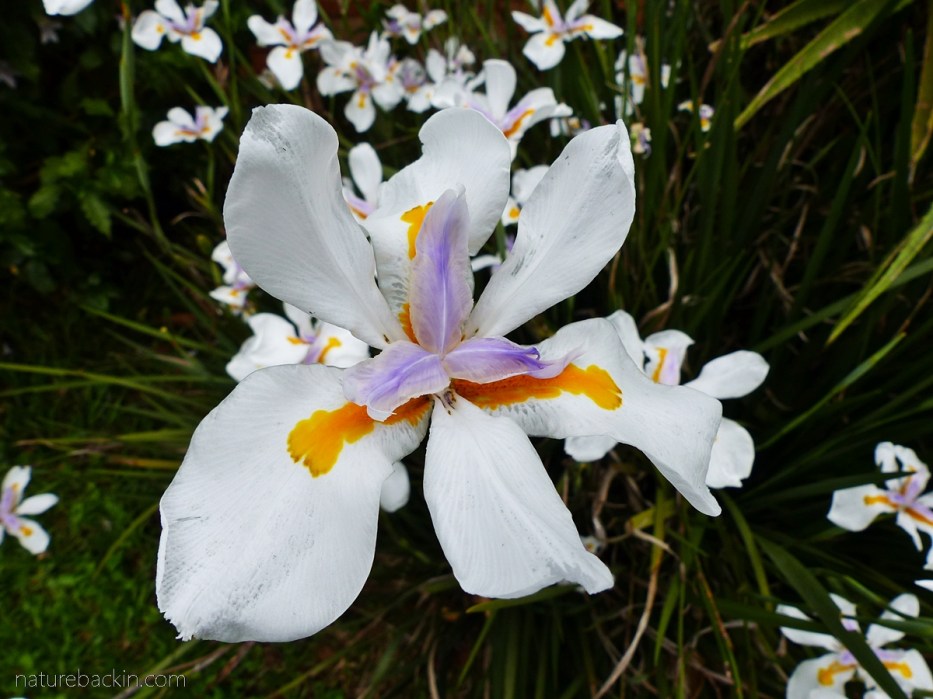
The large wild iris or fairy iris (Dietes grandiflora), in keeping with its natural habitat along forest margins, does well in our garden in sun or semi-shade, perhaps flowering best in full sunshine. In the summer, particularly after rain, the plants are often shimmering with flowers. In its natural habitat it occurs in the the coastal areas of the Eastern Cape and southern KwaZulu-Natal growing in forest margins as well as on exposed slopes facing the sea when partially sheltered by larger shrubs.

The complexity of the flower can be challenging to photograph, but in silhouette the central violet cluster really stands out above the yellow nectar guides on the white petals. The flowers attract honey bees and other pollinators.
Although individual flowers only last a few days, in peak flowering season a succession of flowers makes for a good display over time. The SANBI website’s description of the flower notes that the name ‘fairy iris’ refers not only to the white petals resembling fairy wings, but to the fact that the flowers may disappear mysteriously overnight (http://pza.sanbi.org/dietes-grandiflora).
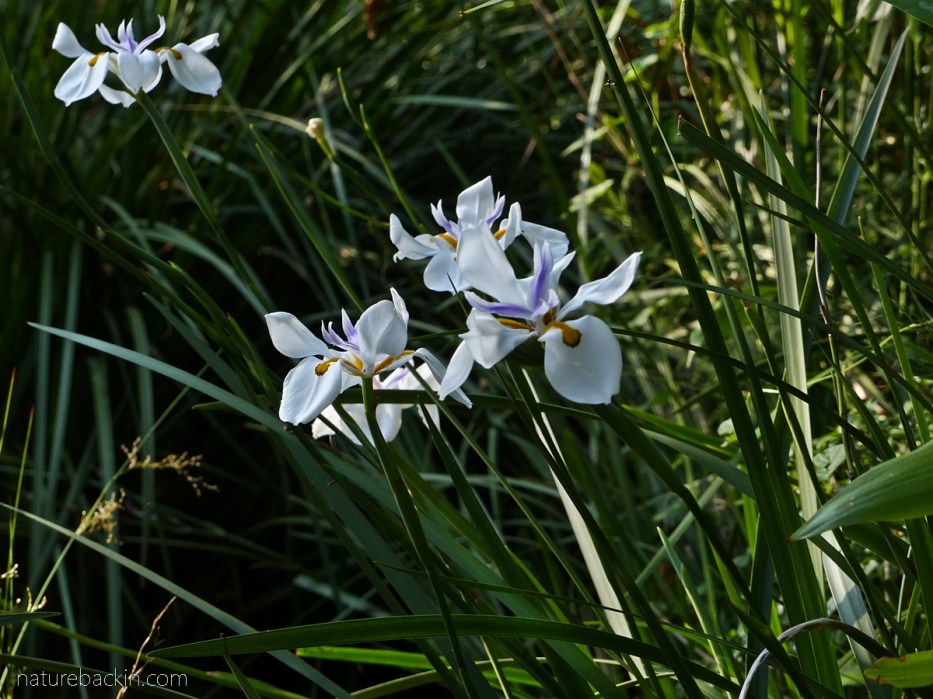
The slender, pointed leaves of the large wild iris may reach a length of about a metre (about 3 feet) and are evergreen, with the plants withstanding dry winter conditions and being frost hardy.

Clumps of Dietes grandiflora, with some of the clumps in flower, help screen a fence between us and our neighbours. Clumps can be dug up and divided as plants multiply easily from their root stems (rhizomes).
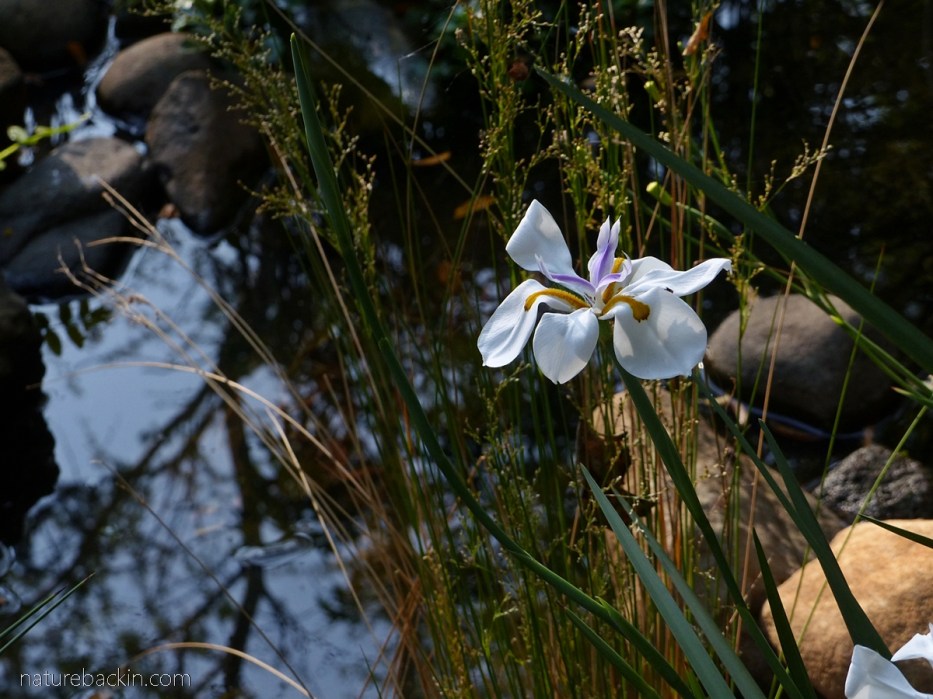
The plants are well suited to planting near a pond or other water feature.

Nestling next to an open flower is the still green and developing seed capsule of an earlier flower on the same stem. The seed capsules slowly dry on the plant, turning to brown.
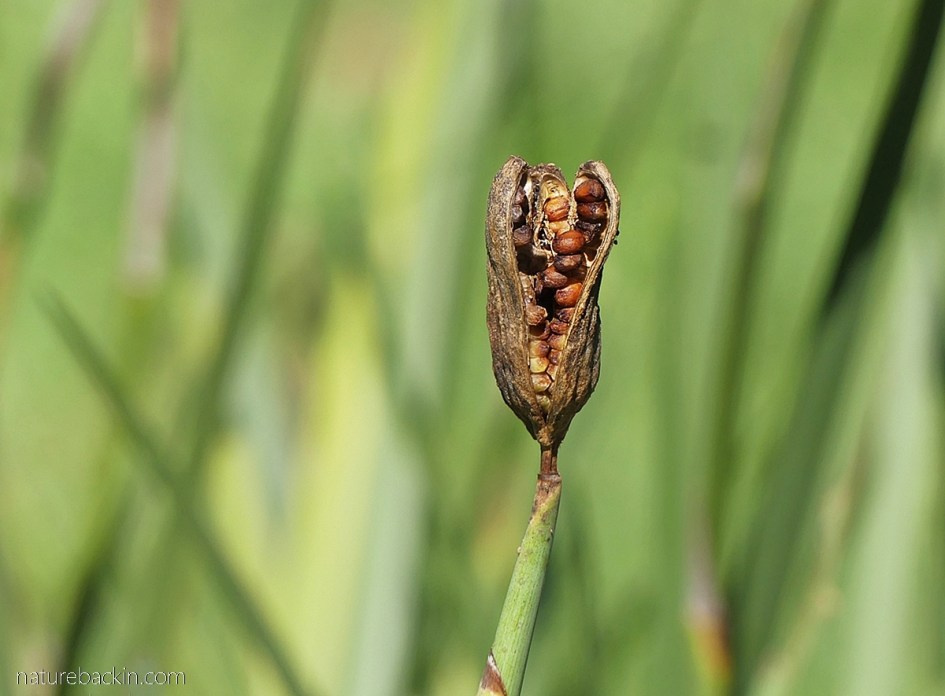
This seed capsule is splitting open to release the seeds within. The Dietes grandiflora self-seeds quite readily and I often find tiny plants growing near to the parent clump. These seedlings can easily be transplanted to other spots in the garden.

As they continue drying the seed capsules open attractively to an almost flower-like shape. The pods can be used in flower arrangements, unlike the flowers themselves that are too ephemeral to be picked for the vase.

It was only while going through a collection of photos I had taken of wild irises that I noticed a cryptically coloured grasshopper well camouflaged in an open dry seed capsule.
There are six species in the Dietes genus, five of which occur in the eastern regions of South Africa. These species are endemic to southern Africa, but some have been exported to other countries and in some regions they have naturalized and unfortunately become invasive, as in parts of Australia for example.
Dietes belong to the Iridaceae family. They used to be classed as Moraea, but were reclassified on account of them having rhizomes rather than corms as in Moraea species. The name Dietes reflects the fact that this genus is associated with two relatives in the Iridaceae family. Derived from Greek word dis, which means twice, and etes, meaning an associate, the Dietes genus is associated with the Moreae and Iris genera (http://pza.sanbi.org/dietes-grandiflora).
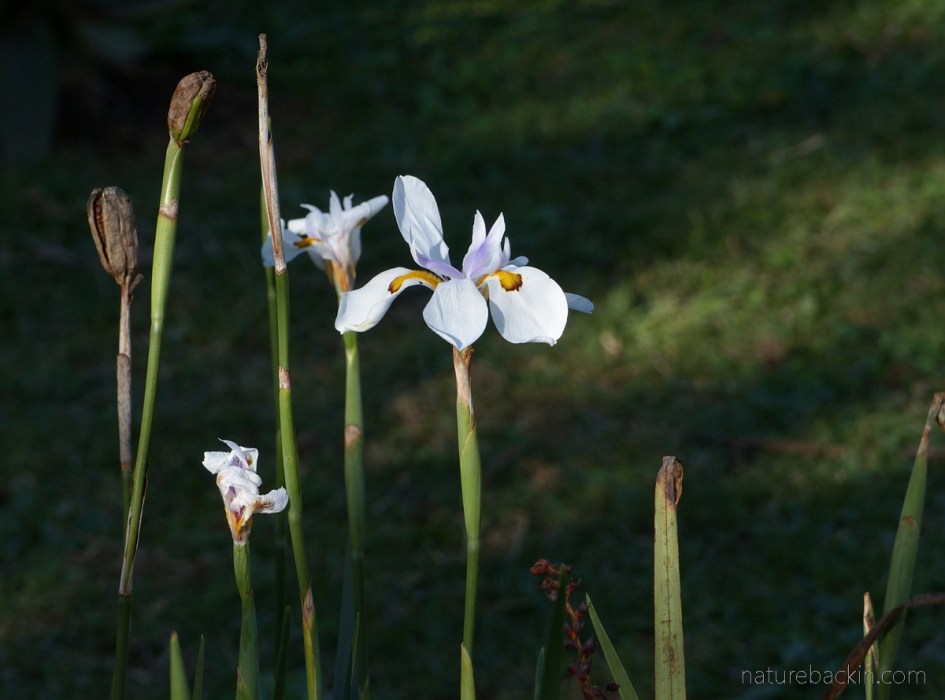
I think that in this photo the Dietes grandiflora looks particularly iris-like. The grandiflora part of its name means large-flowered.
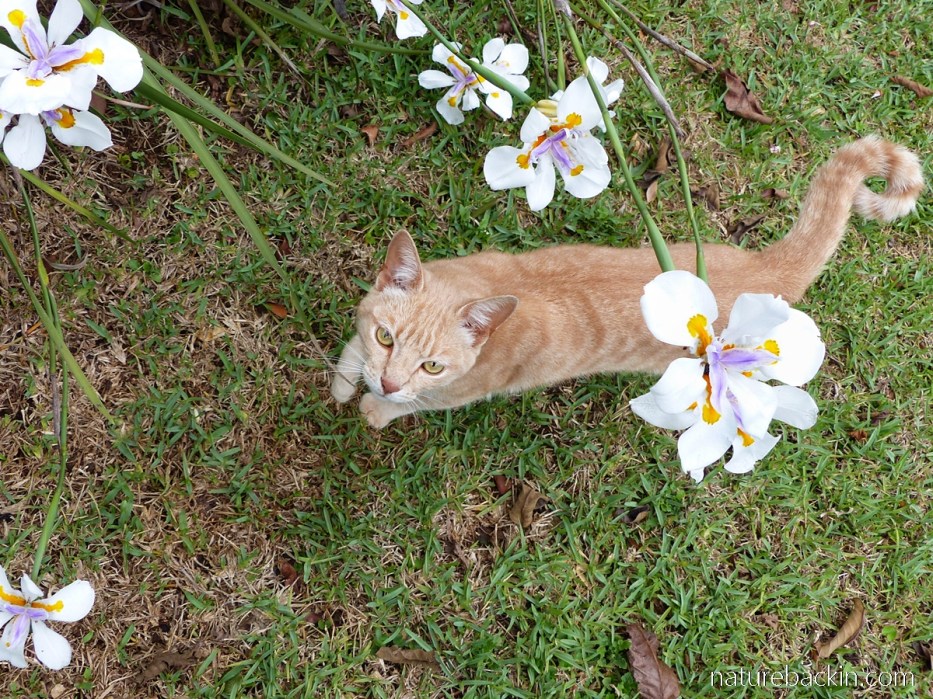
The photos in this post I selected from my collection of wild iris photos taken in the garden over the past few years. I end with a photo of our cat Nougat who came to see what I was up to when photographing wild irises in the cats’ garden. I kind of like the rather random composition.
I had intended to include all three wild irises in this post, but I have decided instead to postpone until next week talking about the yellow wild iris and the less well-known forest wild iris.
Posted by Carol

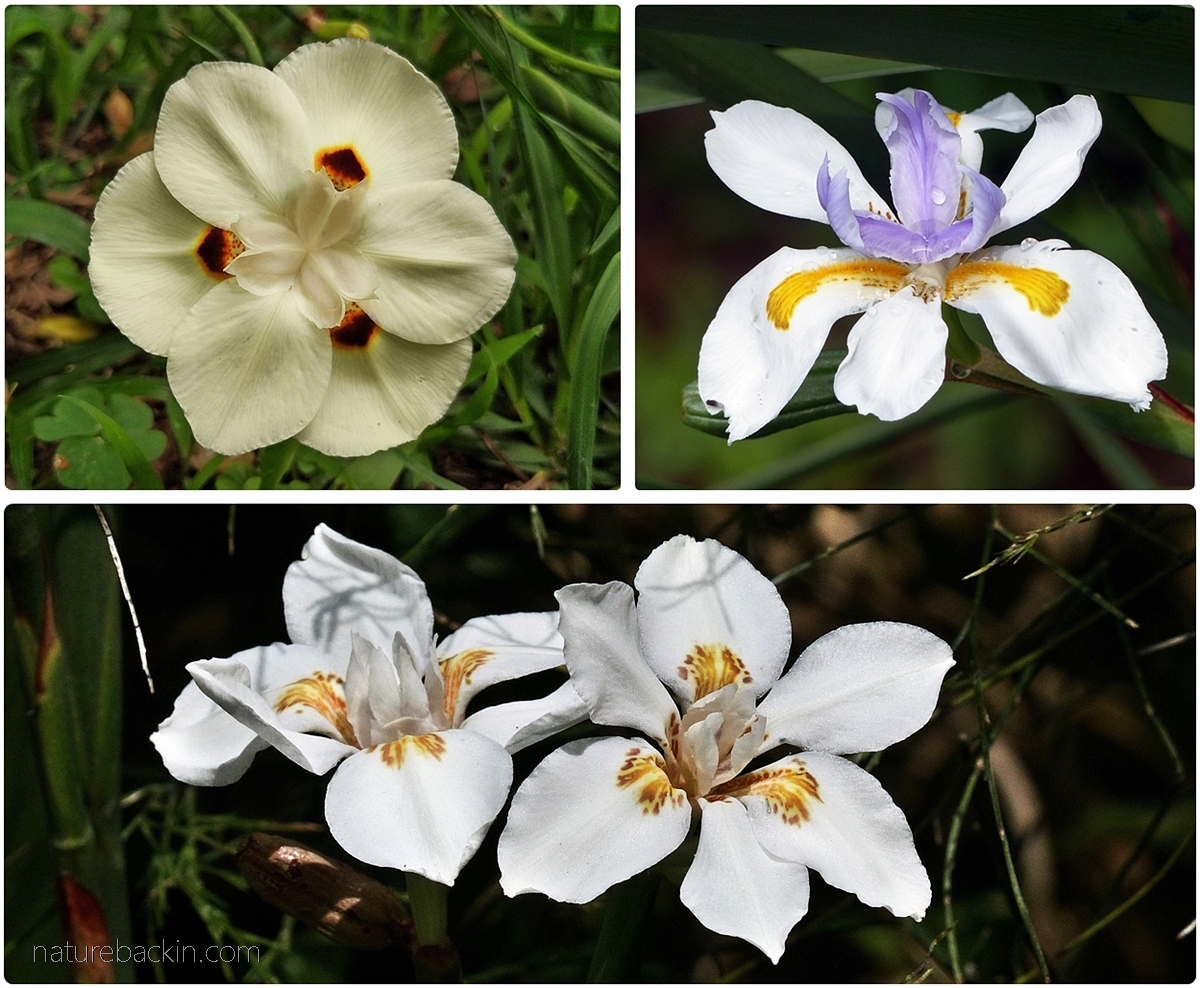







May 31, 2021 at 7:15 am
Beautiful post Carol, I too love these hardy irises. I particularly love your photo of Nougat! xxx
LikeLiked by 1 person
May 31, 2021 at 8:50 pm
Thanks Christeen. It can be easy to take the irises for granted – they are so hardy they are planted everywhere and its possible to overlook how lovely they really are. Nougat just happened to intrude into a spot where I could capture some flowers at the same time without having many options on how to frame the shot. Luckily he has a habit of curling his tail, so it fitted into the frame!
xxx
LikeLiked by 1 person
May 31, 2021 at 1:48 am
These Irises are so beautiful and more ethereal than our New England irises. I love all irises but I’m really taken with the idea that they grow wild. Also, your close-ups are really so crisp and clean! Was that a particular time of day, setting, or just shear grit to get them that way?
And about that Nougat, well, what can you say? The character of that cat! 😉
LikeLiked by 1 person
May 31, 2021 at 8:45 pm
Thanks so much Julie. The photos were selected from quite a collection of images I have of the irises as they are a nice challenge to capture in a way that does them justice. Mostly, I photograph them when its not too bright on account of the white petals flaring out when the light is too bright – so I prefer to try in the ‘golden hours’ or on an overcast day.
It is nice to know that Nougat’s rather over-the-top personality translates even in photos 😺 He certainly is a real character.
LikeLike
June 2, 2021 at 1:29 am
Thanks for those tips!
LikeLiked by 1 person
May 29, 2021 at 6:28 am
Another informative post. Irises are such lovely flowers and have a good deal of variety in their appearance. The grasshopper is such a good capture. Even knowing it’s there, it’s still hard to spot. I also like the photo with your cat, mugging for the camera.
LikeLiked by 1 person
May 31, 2021 at 8:40 pm
The Iris family seems to be particularly large and various but all beautiful. Yes that grasshopper was a surprise when I only noticed it when going through the photos! Nougat the cat is quite an unusual (and persuasive) personality.
LikeLiked by 1 person
May 28, 2021 at 12:53 pm
The Dietes grandiflora grows in profusion in our garden and it certainly is a tough plant. I had always thought that dietes meant “day” and that the plant was so named because the flowers do not last for more than a day. Should I publicise my ignorance! Thanks for setting me right, as it were, Carol.
BTW I noticed during the drought that the plants did not flower, but do respond with flowers after the slightest of rains.
LikeLiked by 1 person
May 28, 2021 at 2:56 pm
I think your interpretation of ‘dietes’ is lovely and most apt 🙂 Until I read for this post I had no idea what the name meant!
It is interesting how quickly the plants respond to rain by producing flowers in what seems like no time at all! It is nice that the leaves remain evergreen even in the driest of times, although some of the leaves do dry off a bit.
LikeLike
May 28, 2021 at 3:51 pm
Yes, it is a very accommodating and tough plant.
I checked, and the Latin for day is ‘dies’, so I had half-remembered it from my school days
LikeLiked by 1 person
May 28, 2021 at 9:36 am
I do love the iris family. I have never managed to grow any but their delicate and complex blooms are a joy when I see them. Here we have the miniature iris reticulata early in the spring and the stately yellow flag iris which grows alongside water much later in the year. And in between many shades of cultivars. Lovely post, Carol!
LikeLiked by 1 person
May 28, 2021 at 2:53 pm
Thanks Sandra. I looked up the Iris reticulata – I don’t recall seeing it before and it looks lovely. I gather its origins are in Turkey and the Caucasian Mountains – is that right?
The yellow flag I have seen in gardens here, often in or nearby ponds or water features – it is indeed a very stately plant.
LikeLiked by 1 person
May 28, 2021 at 8:33 am
I love an iris or so in the garden, and somehow it had never occurred to me to wonder where they could be found in the wild. What a lovely post.
LikeLiked by 1 person
May 28, 2021 at 2:48 pm
Some flowers do seem to have been domesticated forever. I don’t know much about the bearded irises, but they were the first irises I was familiar with as a child. They used to be seen more in gardens here then, but I think many people have given up the battle of caring for them and gardening trends have changed, but where they are happy they are lovely. And of course they enjoyed a high profile partly due to Van Gogh!
LikeLiked by 1 person
May 28, 2021 at 4:37 am
I am so pleased you have focused on these lovely plants! Their hardiness is amazing and I enjoy seeing them blooming in the wild here. Reading about the next ones featured on your photographs is something I am looking forward to 🙂
LikeLiked by 1 person
May 28, 2021 at 2:40 pm
I am glad you enjoy them too and also that you also get to see them in the wild, which I don’t here. The yellow wild irises are less flamboyant but beautiful too.
LikeLiked by 1 person
May 28, 2021 at 2:59 am
All are so beautiful….but the one with the purple center really grabs me!
LikeLiked by 1 person
May 28, 2021 at 2:36 pm
Yes I love that purple centre too.
LikeLiked by 1 person
May 28, 2021 at 2:10 am
A truly fascinating insight into one of our truly beautiful indigenous garden plants! Every home I’ve ever lived in, growing up and in my married life, had these pleasing blooms showing off somewhere.
LikeLiked by 1 person
May 28, 2021 at 2:35 pm
How lovely to grow up with these flowers and to be able to continue to enjoy them. Given their natural mostly coastal habitats it is a bit surprising they cope with frost.
LikeLiked by 1 person
May 29, 2021 at 6:14 am
I’d dare say they cope better with the Highveld frost than most other plants – they’re also often used in municipal “gardens” here in Pretoria, along the pavements of major roadways for instance.
LikeLiked by 1 person
May 28, 2021 at 1:52 am
Another delightful post! You have me wondering if our wild irises are native (as claimed) or escaped from someone’s garden?
I can certainly vouch for your comment that: “The complexity of the flower can be challenging to photograph”. On the other hand, I probably have a harder time of getting back up if I’m on my knees, or worse! 😉
LikeLiked by 1 person
May 28, 2021 at 1:54 am
I forgot to mention that I think your Irises are far prettier than ours.
And that grasshopper… I had to strain my eyes to find him.
LikeLiked by 1 person
May 28, 2021 at 2:33 pm
These irises are lovely, but I am sure they all are in their own way.
The grasshopper is a bit tricky to spot!
LikeLike
May 28, 2021 at 2:32 pm
It will be interesting to trace the origins of the irises that you have.
Well at least one less challenging aspect of the large wild iris is that the flowers are held quite high so no kneeling is required 🙂
LikeLike
May 28, 2021 at 11:22 pm
I almost don’t know where to begin. I suppose there are online resources these days that might identify my volunteer Irises. I did go out yesterday when the light was good to snap a portrait. That might be a start, but today we’re working on putting in a new door and I strained a muscle in my knee a bit. So I’m not being as much help as I had hoped to be. If the pictures turned out any good, I’ll try to post one next time I do a blog. It’s summer- time to do some work on the house! I seem to be slowing down in so many ways! 😉 But still keep plugging along regardless… 😏
LikeLiked by 1 person
May 31, 2021 at 8:38 pm
Ooh it sounds like you are having a stressful time and I hope your knee heals quickly, and that the new door turned out well in the end? Perhaps finding out about the irises can wait until the winter months when there are less pressing things to be done as there are now in the summertime … It’s good to keep plugging along – slow but sure is tried and tested 🙂
LikeLike
May 28, 2021 at 12:03 am
Such lovely iris! They seem to float above their leaves. Too bad they aren’t hardy here (of course I checked!) and they look a bit too large for an indoor plant. 🙂
LikeLiked by 1 person
May 28, 2021 at 2:30 pm
They are lovely and to say they seem to float is a lovely description. True, one region’s hardy does not necessarily translate to another! Definitely they are just a bit too large for an indoor potted plant 🙂
LikeLiked by 1 person
May 27, 2021 at 11:35 pm
Ah! The lovely Dietes! They are exceptionally hardy, and I love the flowers. I have seen both the grandiflora and yellow Dietes in local gardens here in Australia . I have a plant of each colour in mine. I try and remove the finished flowers of both Dietes and Agapanthus (both can be invasive in Qld) to avoid the spread of these plants in the wild, especially as we are located so close to a National Park. I’m looking forward to seeing what the forest Dietes looks like as I can’t recall it. Thanks once again for a lovely post. That little grasshopper was so well camouflaged in the seed pod! Lovely!
LikeLiked by 1 person
May 28, 2021 at 2:26 pm
Yet another group of SA plants doing well in Oz! That is a good idea to remove the flowerheads before they go to seed to prevent the plants from spreading.
The little grasshopper was quite a surprise when I was looking through that batch of photos!
LikeLike